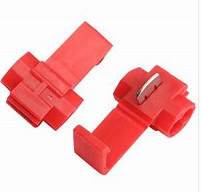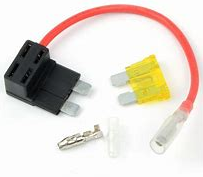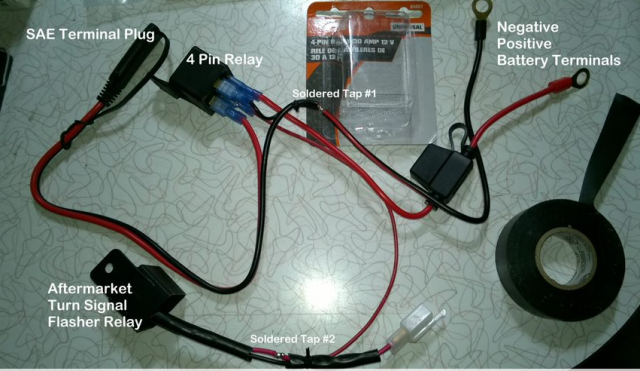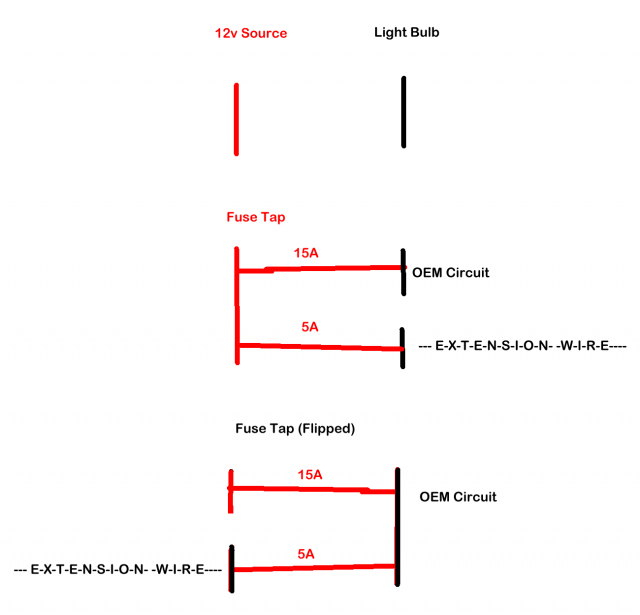Quick Taps:

These go by varying names, such as 'splice', 'connect', etcetera. Their appearances vary quite a bit (not just color) but the function is the same. These tend to cut wire strands, damaging the OEM wire. The wire capacity may be reduced. Over time, the product can further damage wires in automotive environments where vibration, humidity and/or flexing may be factors. https://tech.bareasschoppers.com/resources/the-problem-with-wire-tap-connectors/
Particularly for an automotive environment and using minimum detail, correct way is to carefully strip away some wire insulation and solder on the additional wire. I like to zip-tie the add-on to the original; keeping any stress off the joint and further securing any add-on insulation; whether that be electrical tape or heat shrink tube.
Fuse Taps:

These sometimes go by "Add-A-Circuit" or "fuse holder". These are far more insidious than the quick taps.
These products should be banned until the flawed design is corrected. At the very least, they should be providing clear unavoidable warnings on their packaging with detailed instructions inside. These products probably junk quite a few vehicles over electrical issues. I'd avoid buying anything with one of these installed in any fuse box anywhere in any vehicle.
I've tested one of these types of products before and it's a bad design. I would expect that one of the slots would be the original fuse... for example let's say 15 Amp. Then the second slot would SLAVE off of the original. But that's not how these work. Both fuses are their own circuit. So adding another 5 amp fuse along with the original would potentially put 20 Amps over the original wire. This is really bad design! The added fuse should slave off of the original, in order to avoid the potential of running the feed wire hot. Yes, the original circuit could keep blowing its fuse, but that is INFINITELY better than creating a HIDDEN short, *DEEP* within the potentially tens of feet of wire harness bundles that many vehicles have. It may take weeks, months or even years depending, but a wire that runs hot, will compromise and eventually burn through its insulation... then begin working on the insulation of adjacent wires; shorting shorting unrelated circuits.
Even if you put something on that circuit that only draws 1.5A peak, because the smallest fuse you can install may be 5A, you have no fail-safe! So yes that 1.5A peak draw may be well within the +/- 10% margin for general engineering practice, but if something goes wrong resulting with elevated draw, the aforemetioned insulation hidden deep within some random part of a random wire harness, may be damaged prior to the fuse blowing.
The correct way is to use the fuse tap, only with a slot that is already empty. Install ONE fuse that is ≤ what would've gone into that slot, had it been filled by the OEM. It adds complication but auto manufacturers save natural resources and money by reducing the wire gauge to only what is necessary for fuse panel slots. That's why some slots have thick wires feeding them, and some have small wires feeding them.
If there isn't a working empty slot, then the correct way is to add a relayed terminal to the battery. Your relay should be tapped into a non-critical system; for example...


These go by varying names, such as 'splice', 'connect', etcetera. Their appearances vary quite a bit (not just color) but the function is the same. These tend to cut wire strands, damaging the OEM wire. The wire capacity may be reduced. Over time, the product can further damage wires in automotive environments where vibration, humidity and/or flexing may be factors. https://tech.bareasschoppers.com/resources/the-problem-with-wire-tap-connectors/
Particularly for an automotive environment and using minimum detail, correct way is to carefully strip away some wire insulation and solder on the additional wire. I like to zip-tie the add-on to the original; keeping any stress off the joint and further securing any add-on insulation; whether that be electrical tape or heat shrink tube.
Fuse Taps:

These sometimes go by "Add-A-Circuit" or "fuse holder". These are far more insidious than the quick taps.
These products should be banned until the flawed design is corrected. At the very least, they should be providing clear unavoidable warnings on their packaging with detailed instructions inside. These products probably junk quite a few vehicles over electrical issues. I'd avoid buying anything with one of these installed in any fuse box anywhere in any vehicle.
I've tested one of these types of products before and it's a bad design. I would expect that one of the slots would be the original fuse... for example let's say 15 Amp. Then the second slot would SLAVE off of the original. But that's not how these work. Both fuses are their own circuit. So adding another 5 amp fuse along with the original would potentially put 20 Amps over the original wire. This is really bad design! The added fuse should slave off of the original, in order to avoid the potential of running the feed wire hot. Yes, the original circuit could keep blowing its fuse, but that is INFINITELY better than creating a HIDDEN short, *DEEP* within the potentially tens of feet of wire harness bundles that many vehicles have. It may take weeks, months or even years depending, but a wire that runs hot, will compromise and eventually burn through its insulation... then begin working on the insulation of adjacent wires; shorting shorting unrelated circuits.
Even if you put something on that circuit that only draws 1.5A peak, because the smallest fuse you can install may be 5A, you have no fail-safe! So yes that 1.5A peak draw may be well within the +/- 10% margin for general engineering practice, but if something goes wrong resulting with elevated draw, the aforemetioned insulation hidden deep within some random part of a random wire harness, may be damaged prior to the fuse blowing.
The correct way is to use the fuse tap, only with a slot that is already empty. Install ONE fuse that is ≤ what would've gone into that slot, had it been filled by the OEM. It adds complication but auto manufacturers save natural resources and money by reducing the wire gauge to only what is necessary for fuse panel slots. That's why some slots have thick wires feeding them, and some have small wires feeding them.
If there isn't a working empty slot, then the correct way is to add a relayed terminal to the battery. Your relay should be tapped into a non-critical system; for example...

Last edited:


